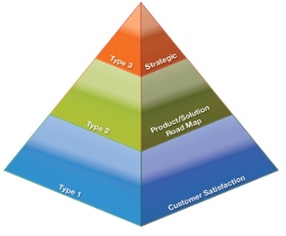Customer and partner advisory boards provide significant value to both the host company and the members. This value, however, can look very different from board to board. The main reason for this is that there are several different types of boards, each of which has its own main focus, goals, intended value and member makeup.
The 3 Types of Advisory Boards (based on their core focus) include:
Type 1: Customer Satisfaction [least strategic]
Comprised of mid-to-low tier management or actual end users, these boards are focused on ensuring customer satisfaction with your offerings is high, and discussions center on ways your organization can do that with better offerings, better services/support, etc. Agenda topics tend to be more on the tactical side of things and very specific tactical action items are the primary objective here. Keeping in mind the fact that boards must be highly relevant to their members, this makes sense. These lower-level, super-user types (of your product) are most concerned about the experience they have with your solution and company than they are about strategic, big-wheel topics.
Type 2: Product/Solution Roadmap
Comprised of users of the product/service, these advisory boards are designed to garner insight on improving the company’s offerings so they better meet your customers’ needs. Typically these customer or partner advisory boards get into the minutiae of your offerings and deep dive on their features, functionality and resulting benefits. The primary objective is to identify areas for improvement in your solutions that will benefit the members and other customers, and will also bring your organization more revenue. Annual or bi-annual meetings typically start out with a very detailed overview of your product/solution roadmap so members can see where you are going with the product. They can then help advise you as to potential/forthcoming missteps or better ways to enhance your offering.
Type 3: Strategic
Comprised of senior level executives, these boards focus on critical issues and opportunities facing the industry that your organization can help its customers address. These boards help drive your strategic direction and go-to-market strategy. Focused mainly on big industry forces, trends, opportunities and threats, discussions tend to stay at a higher, more strategic business direction level. The result of annual/bi-annual meetings or quarterly conference calls is usually a series of key takeaways/insights that your organization can take back and focus on attacking with strategic planning and precise execution. These actions are intended to yield significant growth in revenue, market share and customer base. These strategic level boards are where the real customer-driven business strategies take shape.

